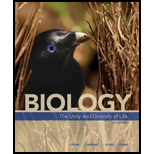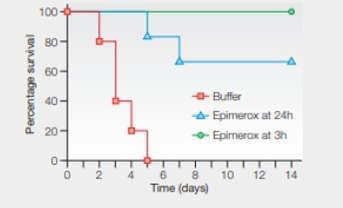
Concept explainers
Bacteriophage-Inspired Antibiotics Although bacteriophages have been infecting bacteria for billions of years, no mechanism, has evolved in bacteria to prevent the viruses from lysing the cell walls of their hosts. Now, scientists are targeting the same bacterial wall components that bacteriophages do. The goal is to develop antibiotics that bacteria will be less likely to develop resistance to.
FIGURE 20.22 shows the results of a study to test Epimerox, a new bacteriophage-inspired antibiotic, against Bacillus anthracis, the bacterial species that causes the disease anthrax.

FIGURE 20.22 Effect of Epimerox on the survival of mice with anthrax. Mice were infected with the bacteria B. anthracis. One group of 15 then began receiving a drug-free buffer solution 3 hours later. Another 15 were treated with Epimerox beginning 3 hours after infection. A third group of 15was treated with Epimerox beginning 24 hours after infection.
How long did it take for all the mice that received the drug-free buffer alone to die? What function did this group play in the experiment?
To determine: The days taken for all the mice to receive the drug-free buffer alone and die.
Introduction: Scientists developed an investigational broad spectrum of an antibiotic compound called Epimerox that inhibits or blocks the activity of an enzyme called epimerase. Epimerase is an enzyme found in Bacillus anthracis that is required to synthesize a polysaccharide in their cell wall. It is also essential for bacterial growth and for receptor expression. Epimerase is used as a model to produce the drug Epimerox. The bacteriophage-lysin enzyme has the capability to specifically bind with epimerase of bacteria and cause cell lysis. Bacillus could not develop a resistant mechanism to prevent the viruses from lysing their host cell wall. This was the idea behind to produce an antibiotic epimerase that could be effective against Bacillus anthracis.
Explanation of Solution
In the given case study, scientists had conducted certain experiments to determine the action of the Epimerox drug. The experimental groups of mice were infected with the bacteria Bacillus anthracis. The mice were grouped into 15 member groups. The first set of mice began to receive drug-free buffer after three hours of infection. At the same time, another set was treated with Epimerox antibiotics. The third set of mice was treated with Epimerox after 24 hours of infection. They observed the survival rate of mice of different groups, and the results were plotted in a graph (Refer Fig 20.2) showing the time (days) of survival versus percentage of survival. Refer Fig 20.2, “Effect of Epimerox on the survival of mice with anthrax”, in the textbook. The graph shows that the group of mice that were injected with drug-free buffer solution died within five days of infection.
The group of mice that were injected with drug-free buffer solution died within five days of infection.
To determine: The role of drug-free buffer in the given experiment.
Introduction: Epimerox inhibits or blocks the activity of an enzyme called epimerase. Epimerase is an enzyme found in Bacillus anthracis that is required to synthesize a polysaccharide in their cell wall. It is also essential for bacterial growth and for receptor expression. Epimerase is used as a model to produce the drug Epimerox.
Explanation of Solution
A solution that will resist the pH change by the addition of either acid or base is called buffer. The buffers are important to maintain the pH of a solution. In the given experiment, drug-free buffer serves as a control group to check the efficiency of the drug Epimerox against the Bacillus anthracis in other groups.
The drug-free buffer served as the control group.
Want to see more full solutions like this?
Chapter 20 Solutions
Biology: The Unity and Diversity of Life (MindTap Course List)
Additional Science Textbook Solutions
Chemistry
Genetics: From Genes to Genomes
Fundamentals of Physics Extended
Campbell Essential Biology (7th Edition)
- Explain how the hormones of the glands listed below travel around the body to target organs and tissues : Pituitary gland Hypothalamus Thyroid Parathyroid Adrenal Pineal Pancreas(islets of langerhans) Gonads (testes and ovaries) Placentaarrow_forwardWhat are the functions of the hormones produced in the glands listed below: Pituitary gland Hypothalamus Thyroid Parathyroid Adrenal Pineal Pancreas(islets of langerhans) Gonads (testes and ovaries) Placentaarrow_forwardDescribe the hormones produced in the glands listed below: Pituitary gland Hypothalamus Thyroid Parathyroid Adrenal Pineal Pancreas(islets of langerhans) Gonads (testes and ovaries) Placentaarrow_forward
- Please help me calculate drug dosage from the following information: Patient weight: 35 pounds, so 15.9 kilograms (got this by dividing 35 pounds by 2.2 kilograms) Drug dose: 0.05mg/kg Drug concentration: 2mg/mLarrow_forwardA 25-year-old woman presents to the emergency department with a 2-day history of fever, chills, severe headache, and confusion. She recently returned from a trip to sub-Saharan Africa, where she did not take malaria prophylaxis. On examination, she is febrile (39.8°C/103.6°F) and hypotensive. Laboratory studies reveal hemoglobin of 8.0 g/dL, platelet count of 50,000/μL, and evidence of hemoglobinuria. A peripheral blood smear shows ring forms and banana-shaped gametocytes. Which of the following Plasmodium species is most likely responsible for her severe symptoms? A. Plasmodium vivax B. Plasmodium ovale C. Plasmodium malariae D. Plasmodium falciparumarrow_forwardStandard Concentration (caffeine) mg/L Absorbance Reading 10 0.322 20 0.697 40 1.535 60 2.520 80 3.100arrow_forward
 Human Heredity: Principles and Issues (MindTap Co...BiologyISBN:9781305251052Author:Michael CummingsPublisher:Cengage Learning
Human Heredity: Principles and Issues (MindTap Co...BiologyISBN:9781305251052Author:Michael CummingsPublisher:Cengage Learning Biology 2eBiologyISBN:9781947172517Author:Matthew Douglas, Jung Choi, Mary Ann ClarkPublisher:OpenStax
Biology 2eBiologyISBN:9781947172517Author:Matthew Douglas, Jung Choi, Mary Ann ClarkPublisher:OpenStax Biology: The Unity and Diversity of Life (MindTap...BiologyISBN:9781305073951Author:Cecie Starr, Ralph Taggart, Christine Evers, Lisa StarrPublisher:Cengage Learning
Biology: The Unity and Diversity of Life (MindTap...BiologyISBN:9781305073951Author:Cecie Starr, Ralph Taggart, Christine Evers, Lisa StarrPublisher:Cengage Learning Biology (MindTap Course List)BiologyISBN:9781337392938Author:Eldra Solomon, Charles Martin, Diana W. Martin, Linda R. BergPublisher:Cengage Learning
Biology (MindTap Course List)BiologyISBN:9781337392938Author:Eldra Solomon, Charles Martin, Diana W. Martin, Linda R. BergPublisher:Cengage Learning Biology Today and Tomorrow without Physiology (Mi...BiologyISBN:9781305117396Author:Cecie Starr, Christine Evers, Lisa StarrPublisher:Cengage Learning
Biology Today and Tomorrow without Physiology (Mi...BiologyISBN:9781305117396Author:Cecie Starr, Christine Evers, Lisa StarrPublisher:Cengage Learning





